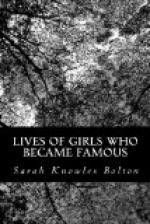They “steamed past the low sandy coast of Patagonia and the rugged mountains of Tierra del Fuego, literally, Land of Fire, so called from the custom the inhabitants have of lighting fires on prominent points as signals of assembly.” The people are cannibals, and naked. “Their food is of the most meagre description, and consists mainly of shell-fish, sea-eggs, for which the women dive with much dexterity, and fish, which they train their dogs to assist them in catching. These dogs are sent into the water at the entrance of a narrow creek or small bay, and they then bark and flounder about and drive the fish before them into shallow water, where they are caught.”
Three of these Fuegians, a man, woman, and lad, come out to the yacht in a craft made of planks rudely tied together with the sinews of animals, and give otter skins for “tobaco and galleta” (biscuit), for which they call. When Lady Brassey gives the lad and his mother some strings of blue, red, and green glass beads, they laugh and jabber most enthusiastically. Their paddles are “split branches of trees, with wider pieces tied on at one end, with the sinews of birds or beasts.” At the various places where they land, all go armed, Lady Brassey herself being well skilled in their use.
She never forgets to do a kindness. In Chili she hears that a poor engine-driver, an Englishman, has met with a serious accident, and at once hastens to see him. He is delighted to hear about the trip of the Sunbeam, and forgets for a time his intense suffering in his joy at seeing her.
In Santiago she describes a visit to the ruin of the Jesuit church, where, Dec. 8, 1863, at the Feast of the Virgin, two thousand persons, mostly women and children, were burned to death. A few were drawn up through a hole in the roof and thus saved.
Their visit to the South Sea Islands is full of interest. At Bow Island Lady Brassey buys two tame pigs for twenty-five cents each, which are so docile that they follow her about the yacht with the dogs, to whom they took a decided fancy. She calls one Agag, because he walks so delicately on his toes. The native women break cocoanuts and offer them the milk to drink. At Maitea the natives are puzzled to know why the island is visited. “No sell brandy?” they ask. “No.” “No stealy men?” “No.” “No do what then?” The chief receives most courteously, cutting down a banana-tree for them, when they express a wish for bananas. He would receive no money for his presents to them.
In Tahiti a feast is given in their honor, in a house seemingly made of banana-trees, “the floor covered with the finest mats, and the centre strewn with broad green plantain leaves, to form the table-cloth.... Before each guest was placed a half-cocoanut full of salt water, another full of chopped cocoanut, a third full of fresh water, and another full of milk, two pieces of bamboo, a basket of poi, half a breadfruit, and a platter of green leaves, the latter being changed with each course. We took our seats on the ground round the green table. The first operation was to mix the salt water and the chopped cocoanut together, so as to make an appetizing sauce, into which we were supposed to dip each morsel we ate. We were tolerably successful in the use of our fingers as substitutes for knives and forks.”




